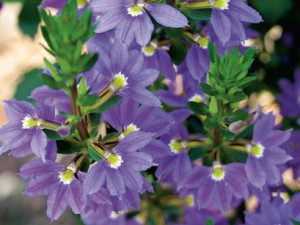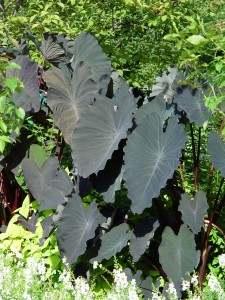Inspired Pot Plants
May 3rd, 2011
It’s easy to get in a pot rut, picking the same worn choices every spring for your containers.
How many pots of red geraniums, spikes and vinca vines do we really need?
One of the best resources for cutting-edge pot-plant ideas is Ray Rogers, a perennial multiple ribbon-winner at the Philadelphia Flower Show and author of “The Encyclopedia of Container Plants” (with Rob Cardillo, Timber Press, 2010, $34.95).
I sat in on a talk Ray did at this year’s Philly Flower Show on some of his favorite pot choices.
Here are a few pot plants he’s particularly high on…
* Scaevola aemula. Fan flower is a common name for this Australian native that blooms blue or bluish-purple and has a trailing habit.
“If there’s one plant you grow in a container, it’s this one,” says Rogers. “It will bloom from the day you put it in in May until frost. It’s never out of bloom.” (Sun or light shade.)
* Angel’s trumpet (Brugmansia). Rogers like these and the closely related datura for their huge, showy, drooping trumpet-shaped flowers, most typically in white, pale pink and soft yellow.
“If I grew only one tropical in a pot, this would be it,” he says.
Both are poisonous, though, so be mindful if you’ve got pets, little kids or hallucinogen-aware teens lurking. (Sun or light shade.)
* Colocasia. Commonly called “elephant’s ears,” this softball-sized summer bulb is grown for the huge leaves – some of which come in black or burgundy/green variegation.
“The leaves are so big you could hide an 8-year-old child in them,” says Rogers.
Bulbs can dug and saved inside over winter for use another year.
* Cannas and callas. People get these two confused, but both are summer bulbs that produce trumpet-shaped flowers.
Cannas are bigger with large leaves (sometimes in black, burgundy or tiger-like variegation), and they bloom at the top of 3- to 4-foot spikes mostly in orange, red or yellow. (Full sun.)
Callas are smaller (1 to 2 feet), have upward-facing flowers (most often white), and many have white-spotted leaves. (Shade or part shade.)
Both also can be saved like colocasia.
* Cactus. “I love cactus in pots,” says Rogers. “They’re not all blobs, heads or pillars.”
These and other worthy succulents (aloes, creeping sedums and echeveria) need much less water than annuals, which is a plus in pots and hanging baskets. (Sun or light shade.)
* Houseplants. Do some pot-plant hunting in the houseplant section, not just around the annuals benches. Most of these do just fine outside in pots. Rogers especially likes snake plants and especially the ones that look tubular (Sansevieria cylindrica).
“Why not use houseplants in your pots?” he asks. “They deserve to be liberated.”
* Hakone grass. This is actually a hardy perennial grass with a beautiful arching habit. It grows only a foot or so tall and comes in golden and gold-variegated versions.
Grow it in the ground and just dig up sections to pot each spring for a money-saving option. (Shade or part shade.)
* Variegated iris. Also a perennial, this 2-foot upright has bladed leaves that are striped white and green. The spring blooms are a bonus – usually in blue or purple.
It’s another that can go in the ground at season’s end.
* Edibles. Just because you can eat a plant doesn’t mean it’s off limits in an ornamental container.
Rogers says purple cabbage looks great in a pot with parsley and sage.
Red mustard, purple basil and all sorts of sages are colorful as well as useful for snipping for the kitchen.
And mints are actually best grown in pots or hanging baskets where their roots won’t run.
“How many of you have grown mint in the open garden and regretted it?” Rogers says.
* Petunias and calibrachoa. So far as conventional annuals go, Rogers puts these two high on his list.
All of the ‘Wave’ petunias and their many new hybrid, cutting-grown brethren are non-stop balls of color (save for occasional mid-summer attacks by budworms).
Calibrachoa or “million bells” have similar trumpet-shaped flowers of most any color, except their leaves and flowers are slightly smaller than petunias (not counting the petite versions of petunias, such as ‘Petitunias,’ ‘Littletunias’ and ‘Mini Me’). (Sun or light shade.)
OK. You’re armed now. Try something new… whether it’s one of these or something that grabs your eye at the garden center.
Life is too short for red geraniums.










